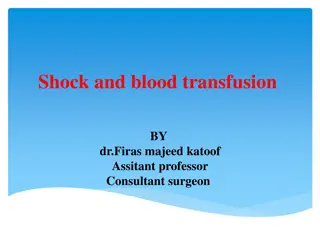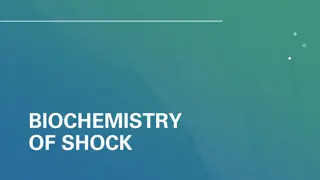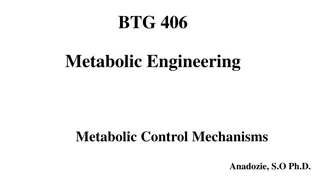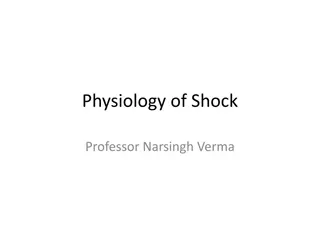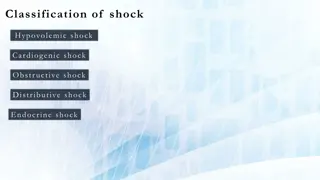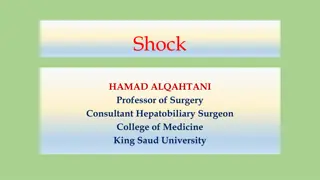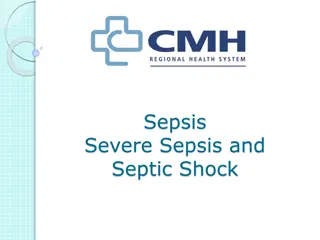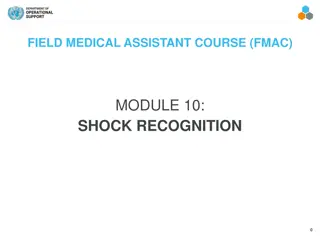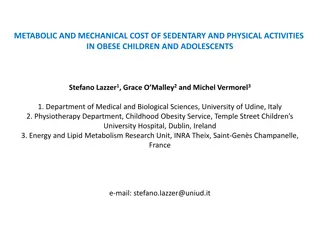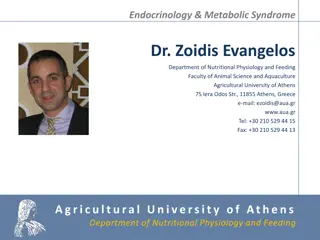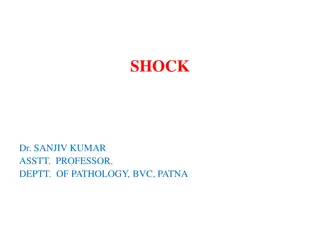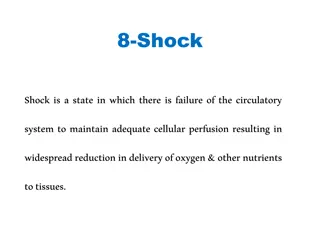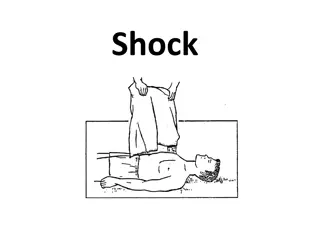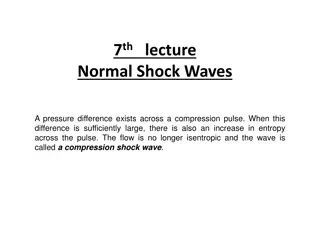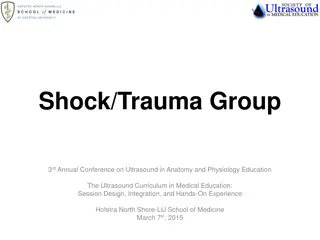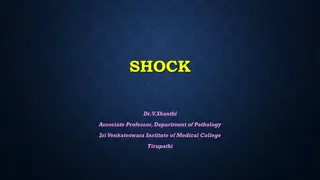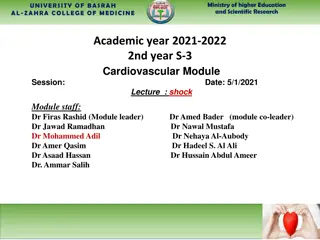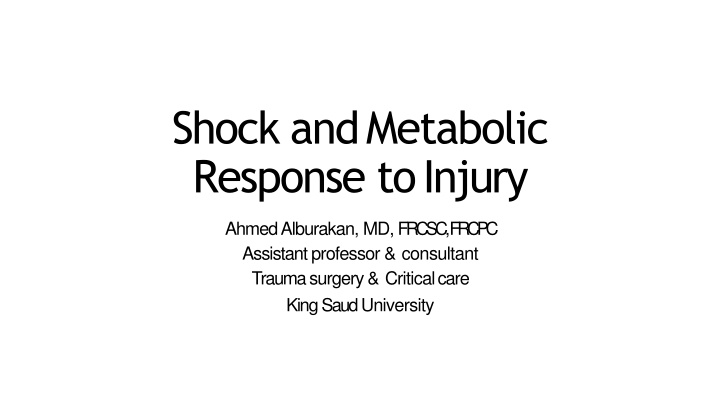
Shock: Causes, Responses, and Complications
Learn about shock, a condition caused by inadequate oxygen delivery leading to tissue hypoperfusion and metabolic acidosis. Explore how the body responds to maintain oxygen delivery, the cellular effects of decreased oxygen, and the progression to multiorgan dysfunction syndrome. Discover different types of shock such as neurogenic, hypovolemic, vasogenic, septic, anaphylactic, and cardiogenic shock.
Download Presentation

Please find below an Image/Link to download the presentation.
The content on the website is provided AS IS for your information and personal use only. It may not be sold, licensed, or shared on other websites without obtaining consent from the author. If you encounter any issues during the download, it is possible that the publisher has removed the file from their server.
You are allowed to download the files provided on this website for personal or commercial use, subject to the condition that they are used lawfully. All files are the property of their respective owners.
The content on the website is provided AS IS for your information and personal use only. It may not be sold, licensed, or shared on other websites without obtaining consent from the author.
E N D
Presentation Transcript
Shock and Metabolic Response to Injury Ahmed Alburakan, MD, FRCSC, FRCPC Assistant professor & consultant Trauma surgery & Criticalcare King SaudUniversity
Shock What isShock?
Shock Inadequate oxygen delivery to meet metabolicdemand. Results in global tissue hypoperfusion and metabolicacidosis Shock can occur with a normal blood pressure, and hypotension can occur without shock
Shock Oxygendelivery isthe functionof the circulatorysystem. This system is basically: - Pump(heart) - Pipes(vessels) - Solution(blood) Needs to function at adequate pressure, volumeand carryingcapacity.
UnderstandingShock Inadequate systemic oxygen delivery activates autonomic responses to maintain systemic oxygendelivery Sympathetic nervoussystem NE, epinephrine, dopamine, and cortisolrelease Causes vasoconstriction, increase in HR, and increase of cardiac contractility (cardiacoutput) Renin-angiotensinaxis Water and sodium conservation andvasoconstriction Increase in blood volume and bloodpressure
UnderstandingShock Cellular responses to decreased systemic oxygendelivery A TP depletion ion pumpdysfunction Cellularedema Hydrolysis of cellular membranes and cellulardeath The body tries to maintain cerebraland cardiac perfusion Vasoconstriction of splanchnic, musculoskeletal, and renal bloodflow Global cellular reliance on anerobic glycolysis and increased lactateproduction. Systemic metabolic lacticacidosis
MultiorganDysfunction Syndrome(MODS) Progression of physiologic effects as shockensues Cardiac depression Respiratorydistress Renalfailure DIC Result is end organfailure
Types OfShock Low peripheral resistancestates ( pipes) Neurogenicshock Loss of sympathetictone Low Cardiac Outputstates Hypovolemic shock ( solution) bleeding Dehydration VasogenicShock Septic Anaphylactic Cardiogenic shock ( pump) Impairedinflow Primary pumpdysfunction Impairedoutflow
TypesOf Shock
Treatment ofShock Goal: Restoreperfusion Method: Depends on type ofShock Reverse the cause.
End Points of Resuscitation inShock management Normal vital signs ( can bemisleading) Normal serum lactatelevels Evidence of adequate tissueperfusion!! -normal mentalstatus. -normal urineoutput. - normal liverfunction. etc.
What Type of Shock isThis? 68 yo M with hx of HTN and DM presents to the ER withabrupt onset of diffuse abdominal pain with radiation tohis low back. The pt is hypotensive, tachycardic, afebrile, with cool but dryskin.
What Type of Shock isThis? 68M with hx of HTN and DM presents to the ER with abruptonset of diffuse abdominal pain with radiation to hislow back. The pt is hypotensive, tachycardic, afebrile, with cool but dryskin. Hypovolemicshock
What Type of Shock isThis? A 34F presents to the ER after dining at a restaurant where shortly after eating the first few bites of her meal, became anxious, diaphoretic, began wheezing, noted diffuse pruritic rash, nausea,and a sensation of her throat closingoff . She is currently hypotensive, tachycardic and ill appearing.
What Type of Shock isThis? A 34F presents to the ER after dining at a restaurant where shortly after eating the first few bites of her meal, became anxious, diaphoretic, began wheezing, noted diffuse pruritic rash, nausea,and a sensation of her throat closingoff . She is currently hypotensive, tachycardic and ill appearing. Anaphylactic
Mediating theResponse The Acute Inflammatory Response Cellularactivation Inflammatory mediators (TNF , IL1,etc) Paracrine Vs endocrineeffects
Mediating theResponse TheEndothelium Selectins, Integrins, andICAMs Nitric Oxide TissueFactor
Mediating theResponse Afferent NerveStimulation Sympathetic NervousSystem Adrenal GlandMedulla
Mediating theResponse The Endocrine System Pituitary Gland (GH, ACTH,ADP) Adrenal Gland (Cortisol,Aldosterone) Pancreatic (Glucagon, Insulin) Others (Renin, Angiotensin, Sex hormones, T4)
Consequences of theResponse Limiting injury Initiation of repairprocesses Mobilization ofsubstrates Prevention of infection Distant organdamage
Metabolic Response toFasting I II III IV V GLUCOSE UTILIZED (g/hora) The carbohydrate deposits of the body last about 18 to 20 hours and new glucose is produced through gluconeogenesis of amino acids from the lean bodymass 40 Exogenous Glycogen Gluconeogenesis 30 20 10 LEGEND II III IV V I GLUCOSE, KETONES GLUCOSE, KETONES FUELFOR BRAIN GLUCOSE GLUCOSE GLUCOSE Ruderman NB. Annu Rev Med 1975;26:248
Starvation Early Stage Muscle Alanine /Pyruvate Brain Glucose Glutamine Gluconeogenesis Glycerol Fat Ketogenesis Ketones AGL Liver Ureagenesis Ketones Urea NH3 Kidney Intestine
Starvation Late Stage Muscle Alanine /Pyruvate Brain Glucose Glutamine Gluconeogenesis Glycerol Ketogenesis Fat Ketones AGL Liver Ureagenesis Ketones Urea NH3 Kidney Intestine
Metabolic Response toStarvation Hormone Norepinephr ine Norepinephr ine Epinephrine Thyroid Hormone T4 Source Sympathetic Nervous System Adrenal Gland Adrenal Gland Thyroid Gland (changes to T3 peripherally) Change in Secretion
Energy Expenditure inStarvation 1 2 Normal Range Partial Starvation 4 Total Starvation Days Long CL et al. JPEN 1979;3:452-456
Metabolic Response toInjury Ebb Phase Flow Phase Expenditure Energy Time Cutherbertson DP, et al. Adv Clin Chem 1969;12:1-55
Metabolic Response toInjury: EbbPhase Characterized by hypovolemicshock Priority is to maintainlife/homeostasis Metabolicrate Cardiacoutput Oxygenconsumption Bloodpressure Tissueperfusion Bodytemperature
Metabolic Response toInjury: FlowPhase Catecholamines Glucocorticoids Glucagon Release of cytokines, lipid mediators Acute phase protein production
Metabolic Response toInjury Fatty Acids Fatty Deposits Endocri ne Respon se Liver & Muscle (glycogen) Gluco se Amino Acids Muscle (amino acids)
Metabolic Response toInjury 2 8 2 4 Nitrogen Excretion 2 0 (g/day) 1 6 1 2 1 0 2 0 3 0 4 0 8 Days Long CL, et al. JPEN 1979;3:452-456 4
Severity of Injury: Effects on NitrogenLosses and MetabolicRate Major Surge ry Moderate to Severe Burn Nitrogen Loss in Sever e Sepsi s Infecti on Urine Electi ve Surge ry Basal Metabolic Rate
Comparing Starvation andInjury Starvati on conserv ed conserv ed slow Trauma or Disease waste d waste d Metabolic rate Body fuels Body protein Urinary nitrogen Weight loss rapi The body adapts to starvation, but not in the presence of critical injury or disease. d Popp MB, et al. In: Fischer JF, ed. Surgical Nutrition 1983.
Modifying theResponse Medication (before or afterinjury) Nutritional status Severity of injury Temperature Anesthetic technique
Summary Injury (Trauma or Surgery) leads to a metabolicresponse Metabolic response to injury is an adaptiveresponse Metabolic response could overwhelm the body and lead toincreased morbidity andmortality We can modify the metabolic response before and sometimes after injury
Metabolic Response toInjury Questions


